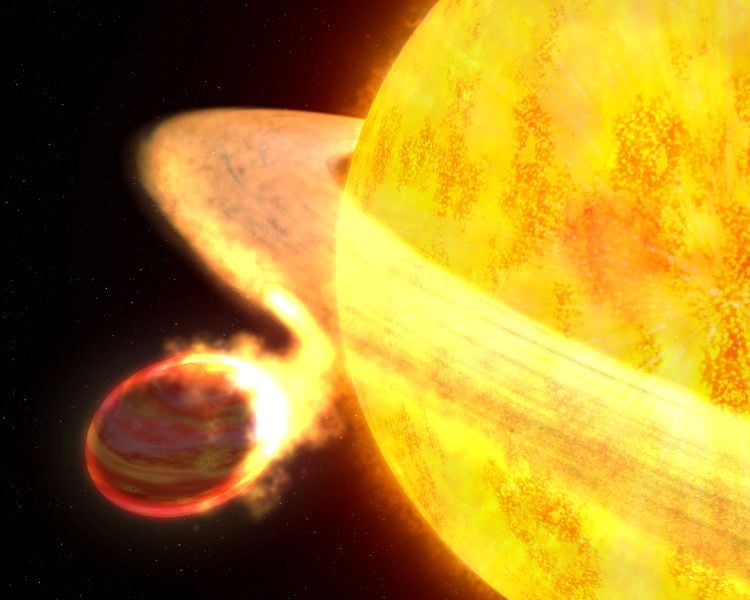Science
Scientists Uncover Atmospheric Escape in Exoplanets Orbiting F-Type Stars

A recent study published in The Astronomical Journal reveals significant findings about atmospheric escape in exoplanets orbiting F-type stars. These stars, larger and hotter than the Sun, present unique conditions that can strip the atmospheres of nearby planets. An international team of researchers conducted an extensive investigation to understand how this phenomenon affects gas giants located in close proximity to their host stars.
The study focused on data from ten transits across six exoplanets gathered using the Wide-field Infrared Camera (WIRC) at the Palomar Observatory, which is operated by the California Institute of Technology. The exoplanets examined included: WASP-12 b, WASP-180 A b, WASP-93 b, HAT-P-8 b, WASP-103 b, and KELT-7 b.
Understanding the amount of atmospheric escape experienced by these exoplanets is crucial as they orbit their stars in extremely tight orbits. The researchers observed that both WASP-12 b and WASP-180 A b exhibited significant signs of atmospheric escape. Meanwhile, WASP-93 b and HAT-P-8 b showed potential indications of atmospheric loss. In contrast, no atmospheric escape was detected for WASP-103 b and KELT-7 b.
Through their analysis, the researchers calculated the atmospheric escape velocities for WASP-12 b and WASP-180 A b at approximately 12.4 grams per second and 11.85 grams per second, respectively, on a logarithmic scale. This translates to actual escape velocities of about 10^12.4 and 10^11.85 grams per second.
This study represents a pioneering effort to assess atmospheric escape for exoplanets around F-type stars, which contrasts with previous research focused on K- and M-type stars. K- and M-type stars are smaller and cooler than our Sun, while F-type stars expose orbiting planets to higher levels of heat and radiation. The effects of this increased exposure can have profound implications for the atmospheres of nearby exoplanets.
One of the primary motivations for investigating atmospheric escape is to enhance our understanding of the long-term evolution of gas giants, particularly those dubbed “hot” Jupiters and “ultra-hot” Jupiters. Studying atmospheric escape also provides insights into star-planet interactions, the composition of exoplanet atmospheres, their potential for habitability, and the validation of planetary models.
As researchers continue to explore the dynamics of atmospheric escape, the findings from this study underscore the importance of examining a broader range of stellar types. This research not only contributes to our understanding of exoplanet formation and evolution but also opens up new avenues for future studies.
The implications of this research could influence how scientists approach the study of atmospheres in exoplanets orbiting F-type stars in the coming years. As the field progresses, the quest for knowledge about our universe continues, and researchers remain committed to uncovering the mysteries of these distant worlds.
-

 World2 weeks ago
World2 weeks agoGlobal Air Forces Ranked by Annual Defense Budgets in 2025
-

 World2 weeks ago
World2 weeks agoMass Production of F-35 Fighter Jet Drives Down Costs
-

 Top Stories2 weeks ago
Top Stories2 weeks agoNew ‘Star Trek: Voyager’ Game Demo Released, Players Test Limits
-

 Science2 weeks ago
Science2 weeks agoTime Crystals Revolutionize Quantum Computing Potential
-

 Top Stories2 weeks ago
Top Stories2 weeks agoDirecTV to Launch AI-Driven Ads with User Likenesses in 2026
-

 World2 weeks ago
World2 weeks agoElectrification Challenges Demand Advanced Multiphysics Modeling
-

 Entertainment2 weeks ago
Entertainment2 weeks agoFreeport Art Gallery Transforms Waste into Creative Masterpieces
-

 Lifestyle2 weeks ago
Lifestyle2 weeks agoDiscover Reese Witherspoon’s Chic Dining Room Style for Under $25
-

 Health2 weeks ago
Health2 weeks agoGavin Newsom Critiques Trump’s Health and National Guard Plans
-

 Lifestyle2 weeks ago
Lifestyle2 weeks agoLia Thomas Honored with ‘Voice of Inspiration’ Award at Dodgers Event
-

 Entertainment2 weeks ago
Entertainment2 weeks agoFast & Furious Coaster Hits the Track at Universal Studios
-

 Science2 weeks ago
Science2 weeks agoWaning Crescent Moon: What to Expect on October 17









